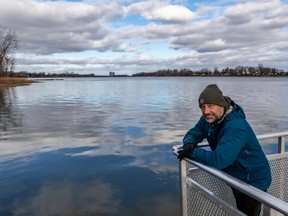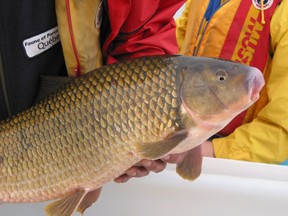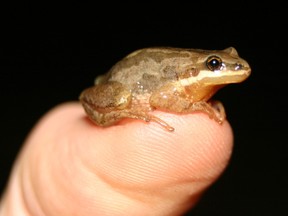Sometimes referred to as “pure laine” fish because they're found nowhere else in the world, the copper redhorse was the first species in Quebec identified as being threatened.

Federal Environment Minister Steven Guilbeault is rejecting calls from scientists who hope he will intervene to stop a Port of Montreal project in the habitat of an endangered fish — the copper redhorse, a species found in Quebec.
“The project has already gone through a rigorous impact-assessment process,” Guilbeault said in response to a reporter’s question at the UN COP15 biodiversity conference currently underway in Montreal.
Sign up to receive daily headline news from the Montreal Gazette, a division of Postmedia Network Inc.
Thanks for signing up!
A welcome email is on its way. If you don't see it, please check your junk folder.
The next issue of Montreal Gazette Headline News will soon be in your inbox.
“It is very challenging for governments. Everything we do as a society, as human beings, has an impact on the environment.”
He said the Liberal government relies on the Canadian Impact Assessment Agency (CIAA) to undertake independent impact reviews.
“So far, I’ve abided by all of their recommendations. I don’t necessarily personally always agree, but we’re committed to depoliticizing impact assessment in Canada.”
Sometimes referred to as “pure laine” fish because they’re found nowhere else in the world, the copper redhorse was the first species in Quebec identified as being threatened, in 1999.
Their habitats have shrunk considerably and are now limited to the St. Lawrence River and spawning grounds in the Richelieu River.
Within that zone, the Montreal Port Authority is proposing an $850-million shipping container terminal. The autonomous federal agency says it needs the new facility in Contrecoeur, 40 kilometres northeast of Montreal, because it’s running out of space at its main terminal.

In its environmental assessment last year, the CIAA said construction and activities at the terminal will affect the environment, including the copper redhorse and its habitat.
The federal review noted the species’ habitat has already deteriorated and fragmented because of agriculture, aquaculture, pollution and the transformation of shorelines.
But the agency gave its blessing, subject to 330 conditions focused on fish, migratory birds, wetlands and First Nations’ use of land and resources. The new terminal still requires two permits from Fisheries and Oceans Canada.
Biologist Alain Branchaud, executive director of the Société pour la nature et les parcs (SNAP Québec), said he was surprised by Guilbeault’s response.
He noted the project’s authorization is conditional on compliance with several recommendations, including obtaining a permit under the federal Species at Risk Act. That permit must be the subject of a separate, independent analysis, he said.
“The federal government must impose on itself the same rigour in the protection of species at risk as it requires of Quebec and other provinces,” Branchaud added.
The CIAA assessment “contains many gaps and (a new review) should start from scratch.”
Branchaud was among a group of prominent Quebec biologists who are urging Guilbeault to intervene.
The Contrecoeur terminal’s “negative impacts on the copper redhorse are underestimated and the benefits of the measures proposed to compensate for the loss of critical habitat are speculative — hypothetical, at best,” they wrote in an advisory report.
Under the port’s plan, “part of the species’ food supply would be permanently destroyed. (And) the construction phase would also lead to the resuspension of significant amounts of sediment and contaminants that could affect the species’ reproduction.”
Environmental groups have vowed to take legal action if Ottawa doesn’t block the plan.
“There are no other similar situations in terms of endemic species in all of Canada — a species as distinctive as the copper redhorse,” Branchaud.
The 30-by-30 goal
Some countries at COP15, including Canada, are pushing for an international commitment to preserve 30 per cent of the world’s land and water by 2030 — a so-called 30-by-30 target.
Scientists say those targets are a minimum if the world is to halt an unprecedented loss of biological diversity, a term that refers to nature — from insects, plants and animals to the forests, streams and oceans they live in.
But certain areas must be prioritized — and Indigenous rights must be respected, environmental groups stressed Thursday at COP15.
“We need to make sure that this is not just any 30 per cent of the planet — the most biodiversity-rich places (must be prioritized),” Brian O’Donnell, director of Campaign for Nature, told reporters.
That means, for example, prioritizing freshwater systems, which are declining faster than any other systems on the planet, he said.
In some areas, more than 30 per cent must be protected, added Jennifer Tauli Corpuz, a representative of the International Indigenous Forum on Biodiversity.
For example, Indigenous groups say the target should be 80 per cent when it comes to the Amazon rainforest, one of the planet’s most biodiverse habitats, she said.

Quebec fulfilled the commitment in the last biodiversity agreement, signed in 2010, protecting 17 per cent of the province’s land base and 10 per cent of its ocean area by 2020, according to the Canadian Parks and Wilderness Society (CPAWS).
And Premier François Legault has committed Quebec to the 30-by-30 target.
But, in a recent report, CPAWS criticized Quebec for lacking “a proper action plan and sufficient financial resources” to reach that goal.
Quebec “continues to entertain the idea of authorizing industrial activities in future conserved areas, such as the Anticosti Island or northern conservation areas,” the organization said.
And it noted the province lacks effective “tools for habitat protection for species at risk.” And, though Quebec protected more than any other province (253,160 square kilometres), there are “significant gaps in protection in southern Quebec.”
CPAWS provided a roadmap Quebec could use to reach 30-by-30:
- In southern Quebec, about 70 forest areas could be protected, including the Noire and Coulonge river watersheds, Lac Walker and Bas-Saint-Laurent sites.
- Several Indigenous-led protection areas could be created, involving Innu communities.
- Northern Quebec’s important carbon stocks could be protected as a contribution to the longstanding commitment to protect 50 per cent of the province’s northern region from industrial activities by 2035.
- Protection of endangered species habitat, including those of barren-ground caribou, woodland caribou and the western chorus frog.

On Thursday, Indigenous and environmental groups stressed that Indigenous Peoples must play central roles in biodiversity protection.
Corpuz, from the Kankanaey Igorot People of Mountain Province in the Philippines, noted Indigenous Peoples and local communities are stewards of more than one-third of the planet, including many areas of high importance for biodiversity.
She said in the past some Indigenous groups have been violently removed from ancestral lands in the name of conservation.
“There are very, very painful stories of how Indigenous Peoples have had rights violated, have been killed, have been taken out of their territory and basically forced to become extinct because of the establishment of protected areas,” Corpuz said
“We cannot achieve ambitious targets without fully reflecting and respecting and protecting the rights of Indigenous Peoples,” Corpuz said.
She praised Canada, saying it is a model for the world on “how to work with Indigenous Peoples to make sure that they lead Indigenous-protected areas.”
On Wednesday, Prime Minister Justin Trudeau announced Ottawa will spend up to $800 million to support Indigenous-led conservation projects in British Columbia, Ontario, the Northwest Territories and Nunavut.
ariga@postmedia.com
-

COP15: Adding monarch butterfly to endangered list could help preserve West Island Technoparc: Guilbeault
-

Saving nature is the goal at COP15 in Montreal. Will Quebec step up?
-

'Make peace with nature': World gathers at Montreal's COP15 to protect biodiversity
-

COP15 FAQ: Why 20,000 delegates are coming to Montreal to talk nature


